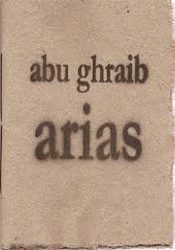
A brutal fact of war: ideologies are constructed and verified through murder and the infliction of pain. The body, in this context, becomes the cipher used to effectuate the “reality” of the ideological gain sought. (This structure remains the same if the gain is “merely” retaliatory.)
In Philip Metres’ abu ghraib arias, the politics of torture are framed through the lyric, itself always already a site of fragmentation and disarticulation, historically, of the Orphic body, and since modernism, as a matter of post-WWII aesthetic orientation.
abu ghraib arias combines elements of resistance literature, erasure poetics, and biblical
hermeneutics, drawing from texts as varied as the Standard Operating Procedure manual for Camp Echo at the Guantanamo Bay prison camp, the testimony of Abu Ghraib torture victims, the words of U.S. soldiers, the Bible, and the Code of Hammurabi to create an echo chamber of words, sounds and images that both bear the weight, and collapse under the weight, of the unspeakable.
From (echo /ex/):
arms behind
Broken because I can’t
sever pain
X
X the hard site
while the earth remaineth
some pictures
shall not cease
One wonders whether Adorno would persist in believing that poetry after Auschwitz was barbaric if he could envision a poetics of formal exigency that, attentive to the actual site of utterance (and the actual sounds, melodic and guttural in turns), challenges Rancière’s idea that war is unrepresentable, as art, as well as to the human perception (the trauma of a terrifying event evoking the imagination’s inability to process the event perceptually, or even conceive of it, as a witness).
 The suffering body is here linked to the breakdown of language: set in relief against interiorized authorial injunctions (“skip lines”; “don’t translate proverbs word for word”), the poet suggests intersections between the “open” (continually written) book of history, and the bound text (if literalized) of revelation or any sacred screed: from “Searching the Koran (Standard Operating Procedure): “the book is/ contours or protusions/ binding/ the binding.”
The suffering body is here linked to the breakdown of language: set in relief against interiorized authorial injunctions (“skip lines”; “don’t translate proverbs word for word”), the poet suggests intersections between the “open” (continually written) book of history, and the bound text (if literalized) of revelation or any sacred screed: from “Searching the Koran (Standard Operating Procedure): “the book is/ contours or protusions/ binding/ the binding.”
If the work of témoignage in literature is to give voice to those whose rights, agency, and dignity were taken, the speaker of this collection restages the disembodied voices of the prisoners but not the recuperation of their names: these unnamed bodies speak within the threshold of survival but not life, though names of the torturers emerge in the “The Blues of [Lane McCotter, Javal Davis, Charles Graner, Lynddie England, Ken Davis, Joe Darby]” series, as if “music” was reduced to noise that drowns out the sounds of pain: “no matter how much/ music you play . . . you can still hear the screams.”
In any context of slavery, torture, or hostage, the self-representation of the subjects through language is taken and means of communication to the “outside” barred: prison narratives, slave narratives, and captivity narratives all attempt to recapture a subjectivity stripped to an object by the agent of control.
In abu ghraib arias the self is reduced to images of its own degradation (“the pictures were taken/ the pictures I gave them/ now they are everywhere and I/ can’t go home again”) as well the disorientation of blindness and deafness punctuated only by the flash of the camera and voice of the torturer, until (in the penultimate (echo /ex/) poem), the pronouns of self- and other-reference collapse into an indistinguishable field of “me” “he” “I” and “He” (trauma as defined, according to Ruth Leys, by the fused identification, with not the disassociation from, the abuser).
The (echo /ex) series is a textual representation of the disarticulated body, heretofore “represented” only by the dissemination of photographs depicting the prisoners’ humiliation: the last poem in this series (the final poem in the book) is a starry constellation of quotation marks and, at the end of the page, framed brackets, as if the end of witnessing is the emptied “frame” of representation itself.
The regained powers of self-objectification, in flesh and blood, is the unwritten sequel to abu ghraib arias, or the “negative” underside to the photographs which manifest the outrage of the Abu Ghraib prison tortures by the 320th Military Police Batallion to the world: prisoner testimonies, in trials and public statements, as well as acts of poetic witness such as Metres’, that “overwrite” the ubiquity of images of torture with the legitimation of language, as living word:
“take the negative from the night
guard and you will find everything I said was true . . . “




